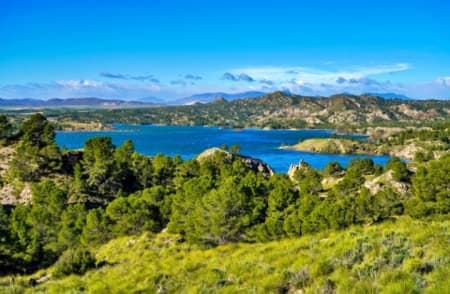
Quipar River
The name of the Quipar river comes from the Arabic Al Quipir. It is a small river, a tributary of the Segura river, which reaches its waters on its right bank leading to it. The river has its source in Caravaca de la Cruz, where various boulevards and streams reach it.
The Quipar river originates at 950 meters above sea level and has a length of 70 kilometres. When it flows into the Segura river, it has an altitude of 230 meters. The Quipar basin is 826 square kilometres in area and is made up of different types of soil, topography, and use, with diverse climatic characteristics.
Likewise, the waters of the Macizo de Revolcadores and the Sierra de Mojantes reach it. On its way, it passes through the Incarnation, which is a strait of singular beauty and archaeological history. Later, it advances parallel to the Argos river, in the municipality of Cehegin. During its tour of this municipality, it advances along the archaeological ruins of Al Quipir, as well as Begastri, which was a Visigothic city.

Subsequently, the Quipar river receives water from the channel that receives water left over from the Argos reservoir, then continues on its way to the Alfonso XIII reservoir, also called the Quipar reservoir, in the municipality of Calasparra. Finally, the Quipar river continues until it empties into the Segura river, of which it is its tributary.
The Quipar river is considered a protected natural element. Hence, it has been declared a Special Protection Area for Birds (ZEPA), called "Sierra del Molino, Quipar Reservoir and Llanos del Cagitan".
The Quipar river is considered a protected natural element. Hence, it has been declared a Special Protection Area for Birds (ZEPA), called "Sierra del Molino, Quipar Reservoir and Llanos del Cagitan".
However, the flow of the Quipar river has been decreasing over time due to the desertification from which the area suffers. This has been degrading its status as a river. Its ecological conditions have declined in quality, its hydrological functions have weakened, the erosion of its soils is evident, and there has been a progressive loss of flora and fauna.
Hence, various initiatives and calls for attention have been made by civil society and environmental organizations, publicizing the need for projects that enable the Quipar river to recover its balance as an ecosystem.
To that end, the respect and recovery of its channel and its shoreline is essential so that, given the morphological conditions, the river is in a position to strengthen its biological functions and protect the fauna and flora associated with its shoreline, which it has been losing. In addition, its soils must be nourished so that water oxygenation and decontamination become possible.
In addition to the contribution that the Quipar river makes to the Segura river, to which it transfers its flow, it is important to support economic activities such as agriculture and livestock, as well as the community and tourist activities that take place more frequently in the areas surrounding the reservoir.














